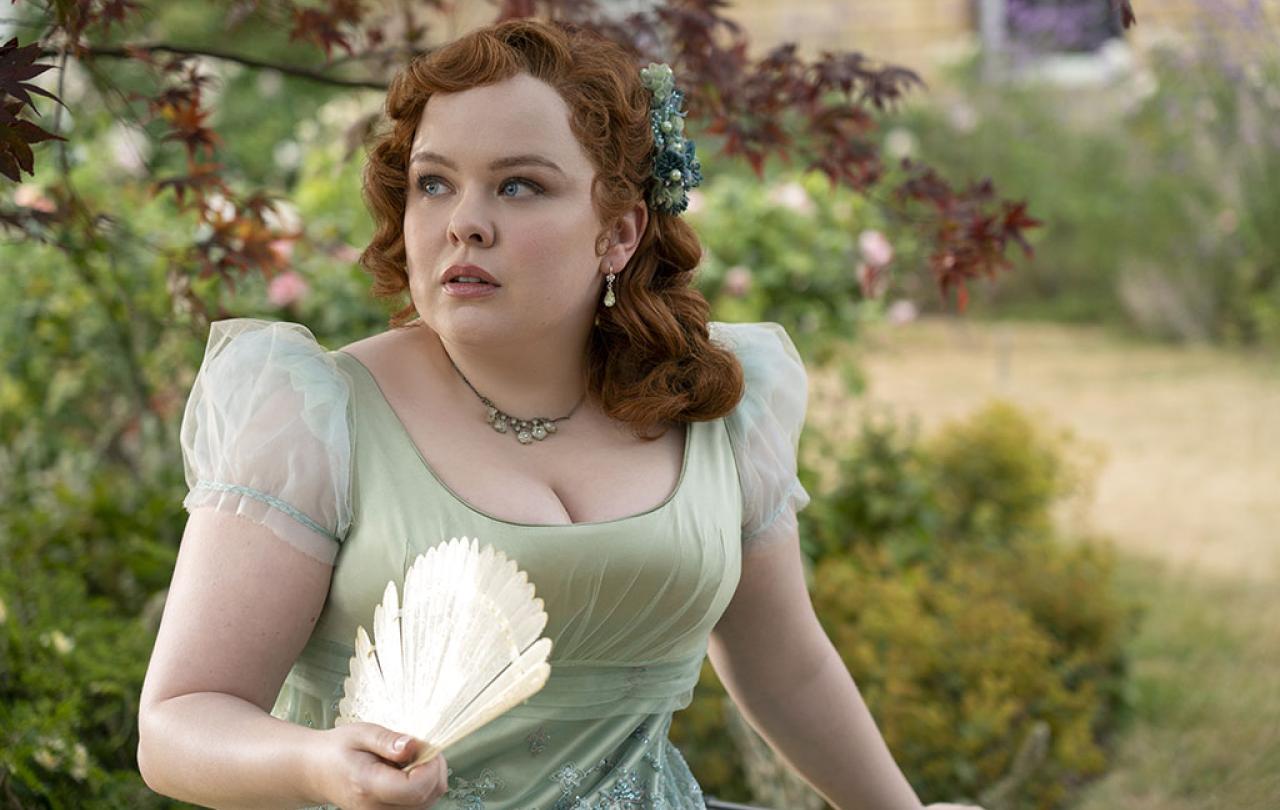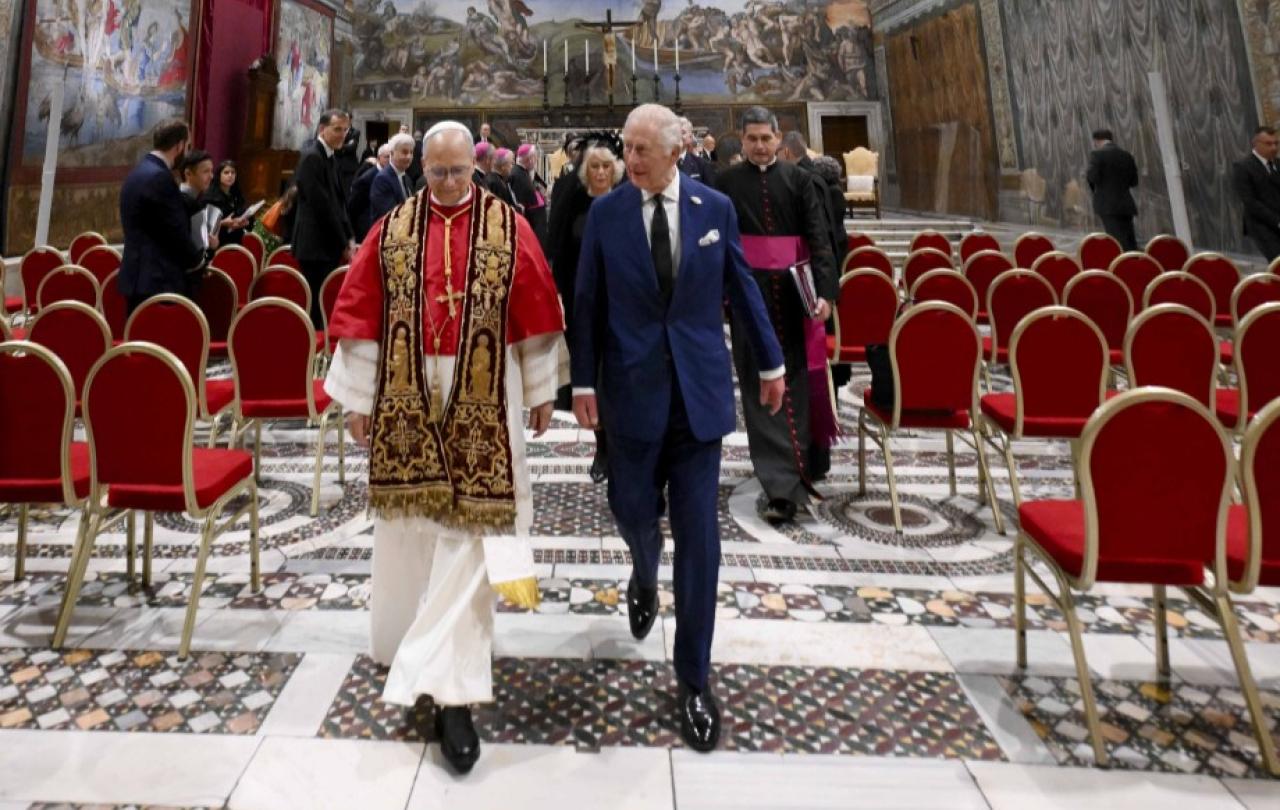
Dearest gentle reader, are there any among us who do not love that most marvellous of transformations, a makeover? Something about a new dress, a new hairstyle, even a new lipstick, somehow has the power to make you feel full of potential. Maybe today will be different. Maybe today I won’t stand on the sidelines. Maybe today, I will be different. A lipstick isn’t going to dramatically change how you look of course – the power is in how it makes you feel. But what do you do when how you feel inside seems so different to how you behave on the outside? When you know that you can be witty, and funny, and charming, but somehow what comes out is shy silence, or worse, utter waffle?
And so, in series three of Bridgerton, the hugely popular Netflix show from Shondaland that brings together regency romance, pop-anthem string covers, colourblind casting and some very modern sensibilities – we see Penelope Featherington, to-date the wallflower of the show, step out from the shadows. She has given herself the most modern of regency style transformations. Her clear instructions to the modiste about her new colour-scheme, her hair, how she wants to present, brook no argument. And she pulls it off with aplomb – the gasps as she descends the inevitable staircase, looking stunning as the strings belt out a-b-c-d-e-f-u, are gratifying. It is hard not to be thrilled for her at the response elicited – the garish citrus florals are gone, and in their place is a new, soft, romantic look, complete with Rita Hayworth hair. She is owning it, finally full of confidence, and it’s fabulous. Our fan-favourite sidekick has become a compelling heroine in her own right.
This third series is full of romance, but also relationships. It is only in figuring out who we are, that we can best relate to others.
But this isn’t the end. This story is just getting started. She might look fabulous, but as Pen tries to launch herself at the town's marriage mart (third time lucky?!) she anxiously fluffs it on an epic scale. And she knows it. Flinging herself onto her bed, she throws down her fan in despair; ‘deep inside, I know I can be clever and amusing but somehow my character gets lost between my heart and sometimes I find myself saying the wrong thing, or more likely, nothing at all’ she explains subsequently. Her work is thriving – as gossip columnist Whistledown she is the talk of the town, making money, with a pen that gives her a power she never dreamed possible as she shares all of Mayfair’s secrets. But her personal life is a mess. On paper she is nailing it; in person she is a disaster.
Charm school isn’t a new concept in a romcom, but nonetheless upon Pen pouring her heart out to long-time crush Colin Bridgerton, he decides to offer a My Fair Lady approach, promising that he has picked up plenty of tips in Paris that he can share. This won’t go exactly according to plan, and the judgement of the town comes down on poor Penelope again, but this series she isn’t going to retreat in shame or fear; the Whistledown in her isn’t prepared to let her go back to just being an accepting wallflower. This series the colours are brighter, the wigs are that much higher, the ballgowns are even more brilliant, and this time, Pen is going to get herself a husband, despite the assumptions and agendas of her truly awful family. And we are here for it - 3.6 million UK-based viewers watched the season 3 premier within a week of release, outperforming the season 2 opener. 'Polin', as fans have named the burgeoning romance between Pen and the newly-buffed up Mr Bridgerton, is perfect for binging.
If the first series of Bridgerton was all about the steamy sex, the second series seemed like it was all about longing and yearning for what couldn’t be, then this third series is full of romance, but also relationships. It is only in figuring out who we are, that we can best relate to others. That might be with potential partners, as Pen rejoices as she finally pulls off a successful interlude with a suitor she concedes – ‘I was feeling so low, in fact it somehow allowed me to stop caring so much about how I was perceived and … I was simply myself’.
God knows us inside and out. He can discern our thoughts from far further away than across a crowded ballroom.
Being confident in who we are is appealing, even in the Bridgerton world, and Lord Debling (her paramour of the moment) acknowledges ‘I want to be with someone who knows who they are and embraces their own peculiarity as I do’. This isn’t purely about who we are on the outside, or on image, but about identity. And how we make that identity authentic, even when we act differently depending on who we are with. Nicola Coughlan who plays Penelope calls this code switching and notes Pen is ‘code switching a little more than most people do’ as she juggles her public role as a debutante with her private role as Whistledown. Maybe we aren’t exactly the same at work as we are with friends, or with our grandma as we are with our partner, but does this make each aspect less authentic?
We may try to choose which aspects we present to our peers or even our partners, but none of those different parts of us can be hidden from God. Terrifying though this might sometimes seem, because as humans we are prone to anxiety and awkward mistakes, God knows us inside and out. He can discern our thoughts from far further away than across a crowded ballroom, and yet he knows how many hairs are on our head (however high it is styled!) – and yet he loves us so much. He already knows the parts of ourselves that we chose to show, and those we try to hide from the rest of the world. As author Philip Yancey wrote ‘There is nothing we can do to make God love us more and there is nothing we can do to make God love us less.’
People, however, are easier to keep secrets from. Pen is still hiding the secret of her alter ego from almost all her friends and family. It’s a secret that has already ruined her relationship with BFF Eloise. Showrunner Jess Brownell has described the will they/won’t they of the wreckage of their friendship as the ‘secondary love story of the season’ noting that like any relationship, friendships just aren’t linear. Nor do all relationships develop in the same way – this series we have seen Mama Bridgerton have her own meet-cute to a Sia soundtrack, and Francesca Bridgerton has herself a very reserved romance incorporating silence and sheet music. This has led to discussions online about whether Fran’s character is on the autistic spectrum due to her introvert nature and rich internal world. Love can come in all shapes and sizes here in the Bridgerton universe – literally as well as figuratively. This reality has room for everyone. But it remains to be seen if Pen and Colin can have a future in a world where both her identities are revealed; he has sworn to ruin Whistledown… when he discovers the truth, will he want to marry his former wallflower?
Bridgerton series 3 part 2 will be released on 13 June.





